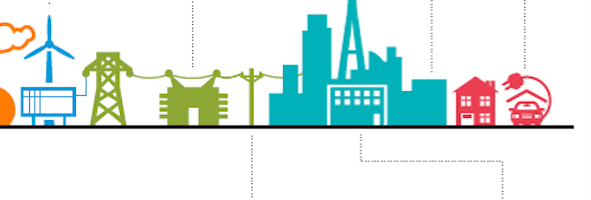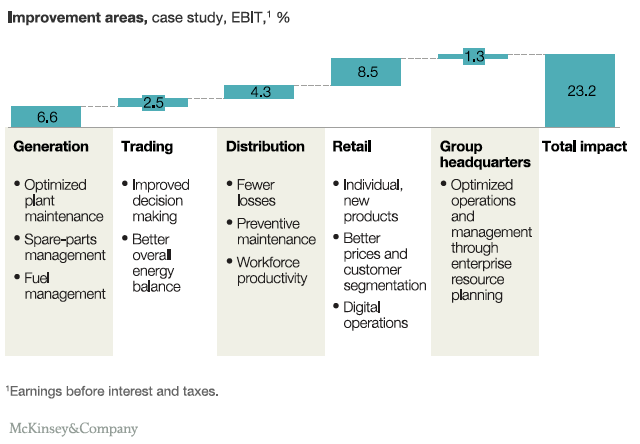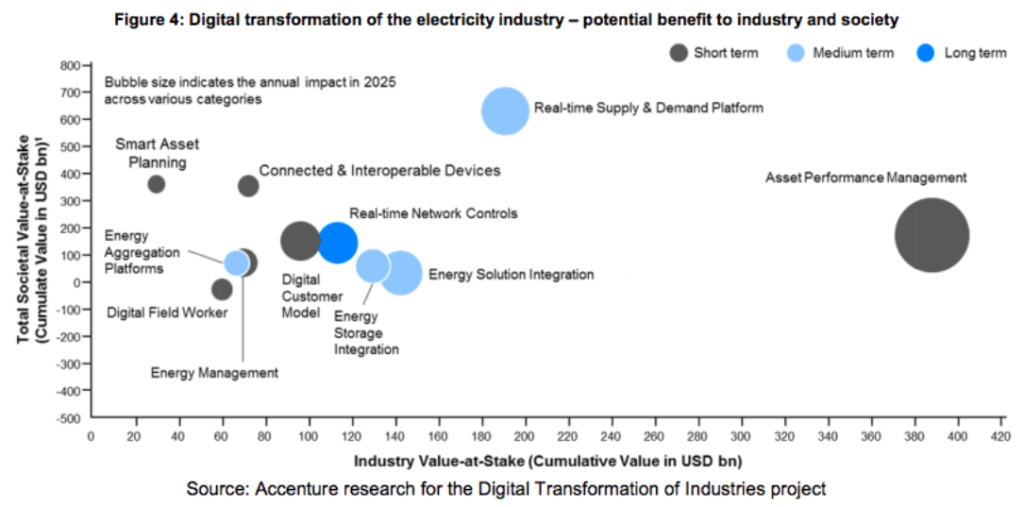A Big Step in Digital Transformation for Electricity: GE and Exelon Seal the Deal

Digital Transformation for Electricity Infrastructure
Last Tuesday, GE announced one of the biggest software deals in company history with electricity giant Exelon, marking what they are calling “the tipping point of the industry where digital transformation of electricity just went mainstream.” Under the agreement, Fortune 100 company Exelon will run its wind, nuclear, hydroelectric, and solar power plants using GE’s Predix platform, a cloud-based operating system developed to improve energy company reliability and efficiency. The companies also intend to later co-develop applications to complement Predix. The anticipated gains span many dimensions. GE predicts increased productivity and savings for Exelon of up to 25 percent in maintenance and operations costs alone.[1]
Market for Digitizing Electricity Infrastructure
Over the next decade, the electricity industry is predicted to unlock approximately $1.3 trillion in value through development and digitization of infrastructure, including platforms, devices, as well as cloud and advanced analytics. Improvements through condition monitoring and predictive forecasting alone could drive $387 billion in added value, the WEF predicts. Digital maturity will be accomplished by equipping energy assets across the value chain (generation, transmission, distribution, consumption) with sensors and cloud-based analytics. The process accelerates as sensor, bandwidth, and computing costs decrease. (According to Harbor Research and GE estimates, more than seven billion devices are predicted to be installed across the energy value chain by 2020.)
Advances in the “infrastructure internet” have unleashed paths for bi-directional energy flows in the grid, real-time demand adjustment, optimized energy supply source combinations, higher electricity output delivery from existing assets, and improved performance in future infrastructure investments. GE explains,
“The future of the power sector is a new value chain augmented and interconnected by digital technologies—one where both power and information flow in multiple directions; all actors add value; and the overall efficiency, cost-effectiveness, resilience, and sustainability of the system are enhanced.”[2]
McKinsey lists specific areas of opportunity across the newly evolving value chain:
(Source: www.mckinsey.com/industries/electric-power-and-natural-gas/our-insights/the-digital-utility-new-opportunities-and-challenges)
As presented in the next two figures, greatest opportunities are predicted at the retail (8.5% EBIT improvement) and generation (6.6%) levels.
(Source: www.mckinsey.com/industries/electric-power-and-natural-gas/our-insights/the-digital-utility-new-opportunities-and-challenges)
This movement has already begun with lower-hanging opportunities to increase efficiency and expand the customer base within the existing value chain (see Figure 4). Utilities are already deploying operational technologies including smart sensors and controls for generation and distribution, automation of substation and distribution, and smart meters.
Business Model and Organizational Model Transformation
Through a radical transformation and improvement in information flow and responsiveness, the modernizing digitized electricity value chain streamlines the real-time intersection of demand and supply, reducing market inefficiencies and allowing players like Exelon and GE to share in that value as providers of a more differentiated (and less commoditized) service and product. Moreover, with the increase of distributed generation and demand management (complementing centralized power), the previous hub-and-spokes model of traditional electricity infrastructure is shifting to a platform model, where multiple network users are enabled interaction through services, products, and information. This allows for enhanced demand response capacity and potential for diversified and more optimal (vis a vis reliability and cost) resource mixes and power flow paths. The revenue stream types are increase in quantity and complexity. From a revenues perspective, the landscape is more competitive but can offer far more value.
Challenges and Risks for the Exelon/GE Partnership and the Broader Industry
Security
Increasing interconnectivity of energy systems spells potentially heightened vulnerabilities as well as the potential for greater ripple effects on energy markets and prices. Moreover, new technologies, including batteries and grid-embedded generation, increase vulnerability of grid systems to cybersecurity threats.
This is in a context of increasing likelihood that future warfare and conflict will focus more heavily on cyber means (due to both global inexperience with handling large-scale cyberattacks and the strengthening capacities of state and non-state actors).[3] In December Ukraine suffered a cyber attack that disrupted power to tens of thousands of people.[4] And security researchers have demonstrated ability to hack into power plants.[5]
Energy actors like GE and Exelon will need to prioritize security measures. This is not just difficult. It plays into what some perceive to be a market failure that businesses cannot address without government regulation and enforcement of standards for numerous low-cost household items. [6] The business community will need to engage heavily with governments to address these market and challenges.
Competition and Workforce
At the end-consumer level, where information (not assets) can be most important, electricity utilities like Exelon will likely face significant competition from digital leaders like Amazon, Google, and Tesla motors. In a new value chain that will likely reap greater rewards for good design, Exelon will be tested on whether its ‘bread and butter’ can dramatically modernize. To that end, competitive recruitment and retention of a competitive and altogether different workforce will be critical.
(800 words)
[1] Kim, Eugene. “GE Signs Software Deal with Electricity Giant Exelon.” November 15, 2016. Business Insider.
[2] General Electric. Powering the Future: Leading the digital transformation
of the power industry. September 2015.
[3] www.weforum.org/agenda/2016/03/3-trends-transforming-the-energy-sector
[4] Zetter, Olivia. “Ukraine Power Grid Hacking: Could it Happen in the United States?” Spring 2016. Belfer Center Newsletter. Harvard Kennedy School. http://belfercenter.ksg.harvard.edu/publication/26469/ukraine_power_grid_hacking.html
[5] www.wired.com/2016/01/everything-we-know-about-ukraines-power-plant-hack/
[6] Schneier, Bruce. “Your WiFi-connected thermostat can take down the whole Internet. We need new regulations.” November 3, 2016. Washington Post. www.washingtonpost.com/posteverything/wp/2016/11/03/your-wifi-connected-thermostat-can-take-down-the-whole-internet-we-need-new-regulations/?utm_term=.c7d3ab1fe05e






Awesome post, and glad to see it highlight what many people think of as an unsexy industry. The power grid is truly critical, and you’re right, the security and talent retention problems are real. On security, I’m not sure it’s even a wise move to try to connect all parts of critical power infrastructure. While there may be a reason for “read only” views into data regarding the power grid, permitting anything more may be riskier than it is worth. On retention, I’m not sure GE is the kind of organization that can refashion its hierarchy and culture to adapt to a competing organization with less at stake. On one hand you want creativity and risk-taking, on another perhaps not so much in the power industry.
Great post, RB! I’m personally concerned that the issue of utility efficiency is not going to make any steps towards improvement until a non-regulatory entity, such as Tesla, takes control of the way that the grid is operated. I consider the Tesla Powerwall (2) to be a fantastically disruptive and inspirationally effective technology. I look forward to the day that Powerwall owners openly publicize the benefits of owning a personal grid efficiency device, and the general public takes control of operating an efficient power grid. (https://www.tesla.com/powerwall)
Great post! I totally didn’t know that industry is predicted to unlock approximately $1.3 trillion in value through various developments. Apart from some straightforward gains in productivity, such as better analytics and smart grid, I would be super interested to analyse the gains related to workforce management. To me, still untapped oppotunity is use of mobile tools, geo-location or gps-navigation which allow for live workforce management. Such systems could also greatly improve data about what the employees in fact do and for how long, which could be transposed into further gains in productivity. Some others great applications of tech in that industry, which are on top of my head are: drone supervision of network and it’s maintanence needs or robots replacing hazardous high voltage jobs.